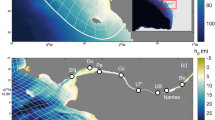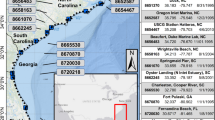Abstract
In response to record-breaking flooding on Lake Champlain in 2011, the International Joint Commission launched a 5-year study to explore solutions to flooding in the binational Lake Champlain-Richelieu River (LCRR) basin. As a component of the study, a real-time flood forecasting modeling system was developed to provide short-term (5 days) water level and wave forecast guidance, intended to enhance flood preparedness by providing advanced warning of flooding to residents and other stakeholders within the basin. The system consists of a hydrodynamic model built on the Finite Volume Community Ocean Model (FVCOM) with one-way coupling to a WAVEWATCH III wave model. The National Water Model stream network was expanded to include the entire LCRR domain and is used to inform river inflows into the system. Water level output from the hydrodynamic model shows strong agreement with gauge observations at annual and short-term time scales, with an increasing negative bias at longer forecast horizons. Modeled significant wave heights compared well with observations from a wave buoy deployed as part of the study and also have a negative bias in the latter portions of the forecast. The scale of the errors in modeled water levels and wave heights is consistent with an underestimation of river inflow and wind speed inputs, respectively, based on validation of this model forcing against available observations. The development and validation of the LCRR modeling system serve as a precursor for the first operational real-time 3D hydrodynamic-wave forecast system for Lake Champlain.










Similar content being viewed by others
Data availability
The modeling datasets generated during the study are available from the corresponding author on reasonable request. Data from the Datawell Directional Waverider 4 buoy are available at the National Data Buoy Center (https://www.ndbc.noaa.gov/).
References
Anderson EJ, Fujisaki-Manome A, Kessler J, Lang GA, Chu PY, Kelley JGW, Chen Y, Wang J (2018) Ice forecasting in the next-generation great lakes operational forecast system (GLOFS). J Mar Sci Eng 6(4):123. https://doi.org/10.3390/jmse6040123
Beletsky D, Titze D, Kessler J, Mason LA, Fry L, Read L, Saunders W, Chu P, Feyen J, Lee D, Kelly JGW, Chen Y, Van der Westhuysen A (2022) Development of coupled hydrologic-hydrodynamic-wave flood forecasting system for Lake Champlain. NOAA Tech. Memo. GLERL-179. NOAA, Great Lakes Environmental Research Laboratory, Ann Arbor, Michigan. https://doi.org/10.25923/2hy2-ca15
Bjerklie DM, Trombley TJ, Olson SA (2014) Assessment of the spatial extent and height of flooding in Lake Champlain during May 2011, using satellite remote sensing and ground-based information: US Geological Survey Scientific Investigations Report 2014–5163. https://doi.org/10.3133/sir20145163
Boudreau P, Cantin JF, Bouchard A, Champoux A, Fortin P, Fiset JM, Fortin N, Thérien J, Morin G (2015) Development of an experimental 2D hydrodynamic model of Lake Champlain using existing bathymetric data. Technical report prepared by Environment Canada for the International Lake Champlain – Richelieu River Technical Working Group. Lake Champlain-Richelieu River 2D Hydrodynamic Model (H2D2). https://legacyfiles.ijc.org/tinymce/uploaded/LCRRTWG/Task_1-2-Lake_Champlain_2D_modeling_EC-NHS_EN.pdf
Campbell MK, White JM (2020) Hydrodynamic modeling of Lake Champlain: current resources, major gaps. Lake Champlain Basin Program and Lake Champlain Sea Grant Institute. https://scholarworks.uvm.edu/lcsg/1
Chen C, Beardsley RC, Cowles G (2006) An unstructured grid, finite volume coastal ocean model (FVCOM) system. J Oceanogr 19:78–89. https://doi.org/10.5670/oceanog.2006.92
Chen C, Beardsley RC, Cowles G, Qi J, Lai Z, Gao G, Stuebe D, Liu H, Xu Q, Xue P, Ge J, Hu S, Ji R, Tian R, Huang H, Wu L, Lin H, Sun Y, Zhao L (2013) An unstructured grid, finite-volume coastal ocean model: FVCOM user manual, Fourth Edition. School for Marine Science and Technology, University of Massachusetts-Dartmouth. SMAST/UMASSD-13–0701
Choi BY, Jo HJ, Lee KH, Byoun DH (2018) Development of wind induced wave predict using revisited methods. J Adv Res Ocean Eng 4(3):124–134
Chu PY, Kelley JGW, Mott GV, Zhang A, Lang GA (2011) Development, implementation, and skill assessment of the NOAA/NOS Great Lakes Operational Forecast System. Ocean Dyn 61(9):1305–1316. https://doi.org/10.1007/s10236-011-0424-5
Cosgrove B, Gochis D, Clark EP, Cui Z, Dugger AL, Feng X, Karsten LR, Khan S, Kitzmiller D, Lee HS, Liu Y, McCreight JL, Newman AJ, Oubeidillah A, Pan L, Pham C, Salas F, Sampson KM, Sood G, Wood A, Yates DN, Yu W (2016) An overview of the national weather service national water model. American Geophysical Union Fall Meeting 2016 Abstract H42B-05.
Donelan MA (1980) Similarity theory applied to the forecasting of wave heights, periods and directions. National Water Research Institute
Dowell DC, Alexander CR, James EP, Weygandt SS, Benjamin SG, Manikin GS, Blake BT, Brown JM, Olson JB, Hu M, Smirnova TG (2022) The high-resolution rapid refresh (HRRR): an hourly updating convection-allowing forecast model. Part 1: Motivation and system description. Weather Forecast 37(8):1371–1395. https://doi.org/10.1175/WAF-D-21-0151.1
Environment and Climate Change Canada (ECCC) (2022) Hydrometric data. https://wateroffice.ec.gc.ca. Accessed September 2022
Environmental Modeling Center (EMC) (2022) EMC operational wave models. https://polar.ncep.noaa.gov/waves. Accessed September 2022
Flynn RH, Rydlund PH Jr, Martin DJ (2016) Network global navigation satellite system surveys to harmonize American and Canadian datums for the Lake Champlain Basin. US Geological Survey No 2016–5009. https://doi.org/10.3133/sir20165009
Forest Ecosystem Management Cooperative (FEMC) (2022) FEMC data archive. https://www.uvm.edu/femc/data. Accessed September 2022
Fortin V, Gaborit E, Dimitrijevic M (2015) Assessing the skill of weather forecasts for the purpose of flood forecasting in Lake Champlain and Richelieu River. Technical report prepared for the International Lake Champlain – Richelieu River Technical Working Group. https://legacyfiles.ijc.org/tinymce/uploaded/LCRRTWG/Task_1-1_Weather_Forecast_Evaluation_Lake_Champlain_EC-RPN-e_EN_1.pdf
Global Systems Laboratory (GSL) (2022). The high-resolution rapid refresh (HRRR). https://rapidrefresh.noaa.gov/hrrr. Accessed September 2022
Herdman L, Manley T, Mehler P, Kernkamp H (2019) Causeways and circulation in Lake Champlain. Presented to the International Association of Great Lakes Research. June 2019. https://ny.water.usgs.gov/projects/champlain/LakeChamplain_USGSapproved.pdf
International Lake Champlain-Richelieu River Study Board (ILCRRSB) (2019) The causes and impacts of past floods in the Lake Champlain-Richelieu River basin, historical information on flooding: a report to the International Joint Commission. https://www.ijc.org/sites/default/files/2020-03/9056-CMI%20Rapport%20public%20EN-FINAL-HR.pdf
International Lake Champlain-Richelieu River Study Board (ILCRRSB) (2022) Development of a binational flood forecasting and real-time flood plain mapping system for operational implementation: a report to the International Joint Commission. https://www.ijc.org/sites/default/files/LCRR_Flood_Forecasting_EN_060822.pdf
James EP, Alexander CR, Dowell DC, Weygandt SS, Benjamin SG, Manikin GS, Brown JM, Olson JB, Hu M, Smirnova TG, Ladwig T (2022) The high-resolution rapid refresh (HRRR): an hourly updating convection-allowing forecast model. Part 2: Forecast Performance. Weather Forecast 37(8):1397–1417. https://doi.org/10.1175/WAF-D-21-0130.1
Kelley JGW, Chen Y, Anderson EJ, Lang GA, Xu J (2018). Upgrade of NOS Lake Erie Operational Forecast System (LEOFS) to FVCOM: model development and hindcast skill assessment. United States Coast Survey Development Laboratory. NOAA technical memorandum NOS CS 40. https://doi.org/10.7289/V5/TM-NOS-CS-40
Kelley JGW, Chen Y, Anderson EJ, Lang GA, Peng M (2020) Upgrade of NOS Lake Michigan and Lake Huron operational forecast systems to FVCOM : model development and hindcast skill assessment. United States Coast Survey Development Laboratory. NOAA technical memorandum NOS CS 42. https://doi.org/10.25923/mmyb-qh56
Lake Champlain Basin Program (LCBP) (2013) Flood resilience in the Lake Champlain basin and Upper Richelieu River
Marti CL, Schroth AW, Zia A (2019) Physical and biogeochemical processes across seasons in Missisquoi Bay, Lake Champlain: insights from a three-dimensional model. American Geophysical Union Fall Meeting December 2019 Abstract H34C-04
McKay L, Bondelid T, Dewald T, Johnston J, Moore R, Rea A (2012) NHDPlus version 2: user guide. https://nhdplus.com/NHDPlus/NHDPlusV2_documentation.php
Mendelsohn D, Isaji T, Rines H (1995) Hydrodynamic and water quality modeling of Lake Champlain. Report to Lake Champlain Management Conference. http://www.lcbp.org/wp-content/uploads/2013/03/19_Hydrodynamic_and_WQ_Modeling.pdf
Mendelsohn D, Swanson C, Isaji T (1997) Hydrodynamic modeling of Missisquoi Bay in Lake Champlain. Final report submitted to Vermont Geological Survey, Vermont Agency of Natural Resources. https://anrweb.vt.gov/PubDocs/DEC/WSMD/lakes/Docs/lp_missisquoibayhydromodel.pdf
National Centers for Environmental Information (NCEI) (2022) Global forecast system (GFS). https://www.ncei.noaa.gov/products/weather-climate-models/global-forecast. Accessed September 2022
Office of Water Prediction (OWP) (2022). The national water model. https://water.noaa.gov/about/nwm. Accessed September 2022
Peng M, Schmalz RA Jr, Zhang A, Aikman F III (2014) Towards the development of the national ocean service San Francisco Bay Operational Forecast System. J Mar Sci Eng 2(1):247–286. https://doi.org/10.3390/jmse2010247
Riboust P, Brissette F (2015) Climate change impacts and uncertainties on spring flooding of Lake Champlain and the Richelieu River. J Am Water Resour Assoc 51(3):776–793
Riboust P, Brissette F (2016) Analysis of Lake Champlain/Richelieu River’s historical 2011 flood. Can Water Resour J 41(1–2):174–185. https://doi.org/10.1080/07011784.2014.982190
Stickney M, Hickey C, Hoerr R (2001) Lake Champlain basin program: working together today for tomorrow. Lakes Reserv: Res Manag 6(3):217–223. https://doi.org/10.1046/j.1440-1770.2001.00150.x
The WAVEWATCH III Development Group (WW3DG) (2019) User manual and system documentation of WAVEWATCH III version 6.07. Tech Note 333, NOAA/NWS/NCEP/MMAB, College Park, MD, USA
Touma JS (1977) Dependence of the wind profile power law on stability for various locations. J Air Pollut Control Assoc 27(9):863–866. https://doi.org/10.1080/00022470.1977.10470503
United States Geological Survey (USGS) (2022) USGS water data for the nation. https://waterdata.usgs.gov/nwis. Accessed September 2022
United States National Ice Center (USNIC) (2008). IMS daily northern hemisphere snow and ice analysis at 1 km, 4 km, and 24 km resolutions, version 1. Updated Daily. https://doi.org/10.7265/N52R3PMC. Accessed September 2022
Wei E, Zhang A, Yang Z, Chen Y, Kelley JG, Aikman F, Cao D (2014) NOAA’s nested northern Gulf of Mexico operational forecast systems development. J Mar Sci Eng 2(1):1–17. https://doi.org/10.3390/jmse2010001
Funding
This work was funded by the International Joint Commission Lake Champlain-Richelieu River Study. Funding was awarded to the Cooperative Institute for Great Lakes Research (CIGLR) through the NOAA Cooperative Agreement with the University of Michigan (NA17OAR4320152). This is NOAA GLERL Contribution No. 2019 and CIGLR Contribution No. 1213.
Author information
Authors and Affiliations
Corresponding author
Ethics declarations
Competing interests
The authors declare no competing interests.
Additional information
Responsible Editor Ricardo de Camargo
This article is part of the Topical Collection on the 12th International Workshop on Modeling the Ocean (IWMO), Ann Arbor, USA, 25 June – 1 July 2022
Rights and permissions
About this article
Cite this article
Titze, D., Beletsky, D., Feyen, J. et al. Development and skill assessment of a real-time hydrologic-hydrodynamic-wave modeling system for Lake Champlain flood forecasting. Ocean Dynamics 73, 231–248 (2023). https://doi.org/10.1007/s10236-023-01550-2
Received:
Accepted:
Published:
Issue Date:
DOI: https://doi.org/10.1007/s10236-023-01550-2




